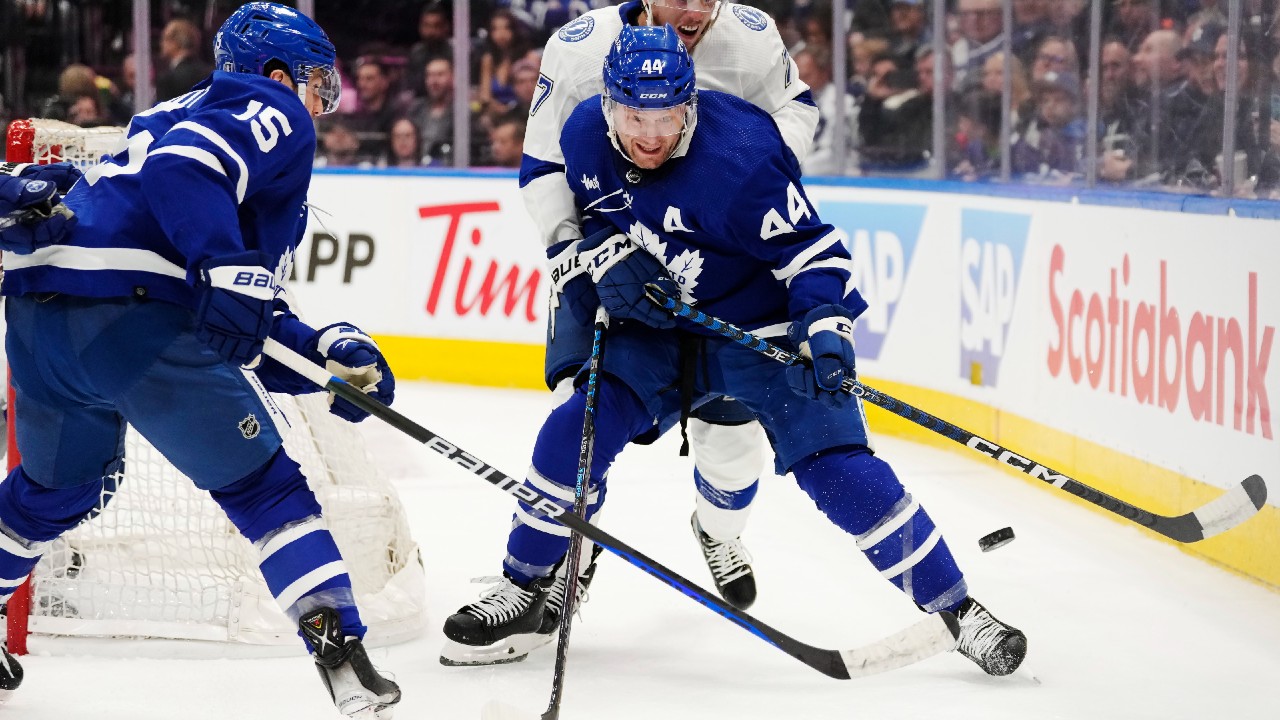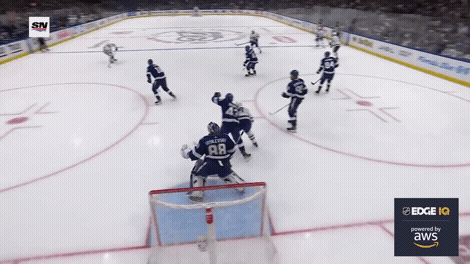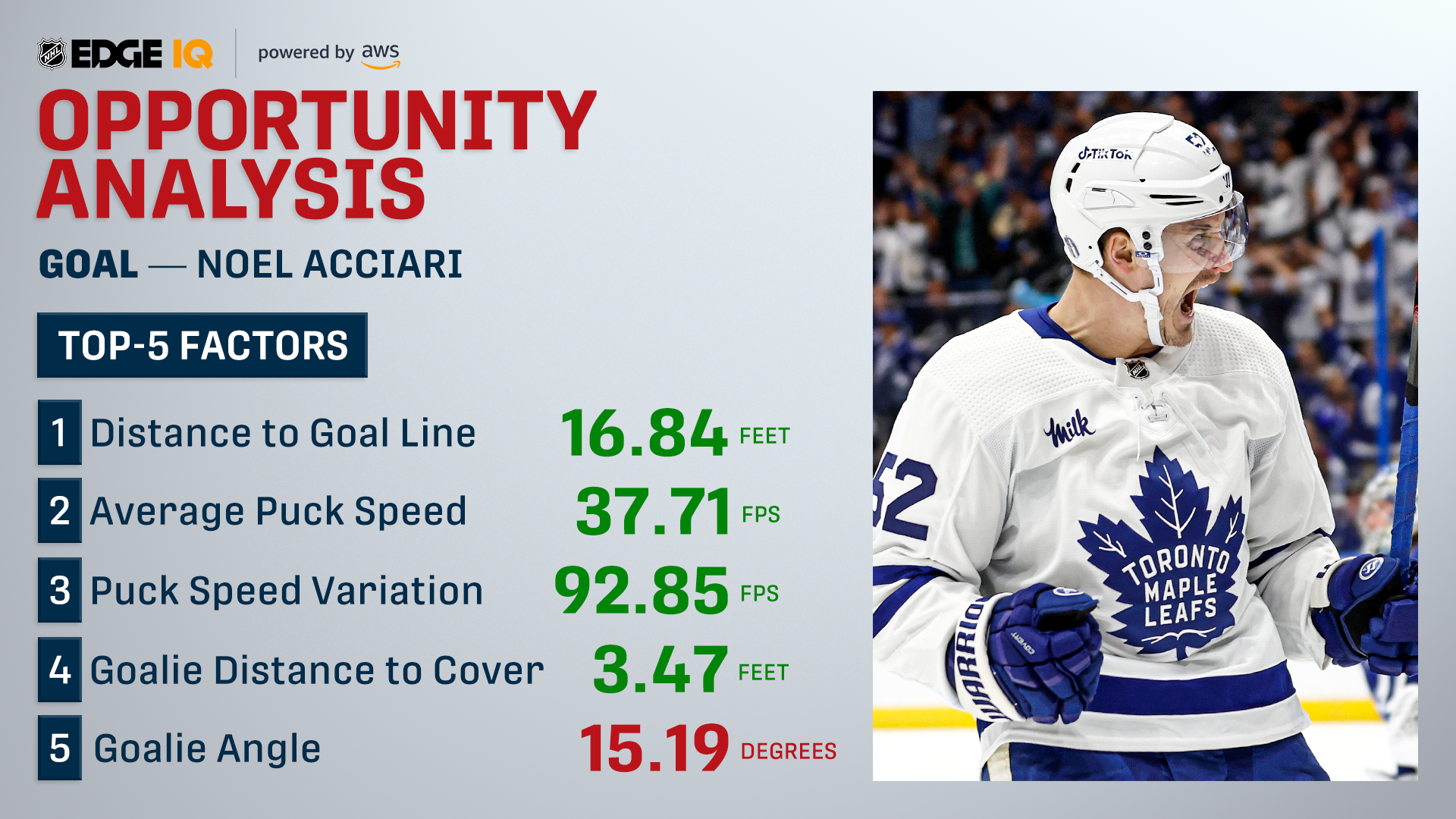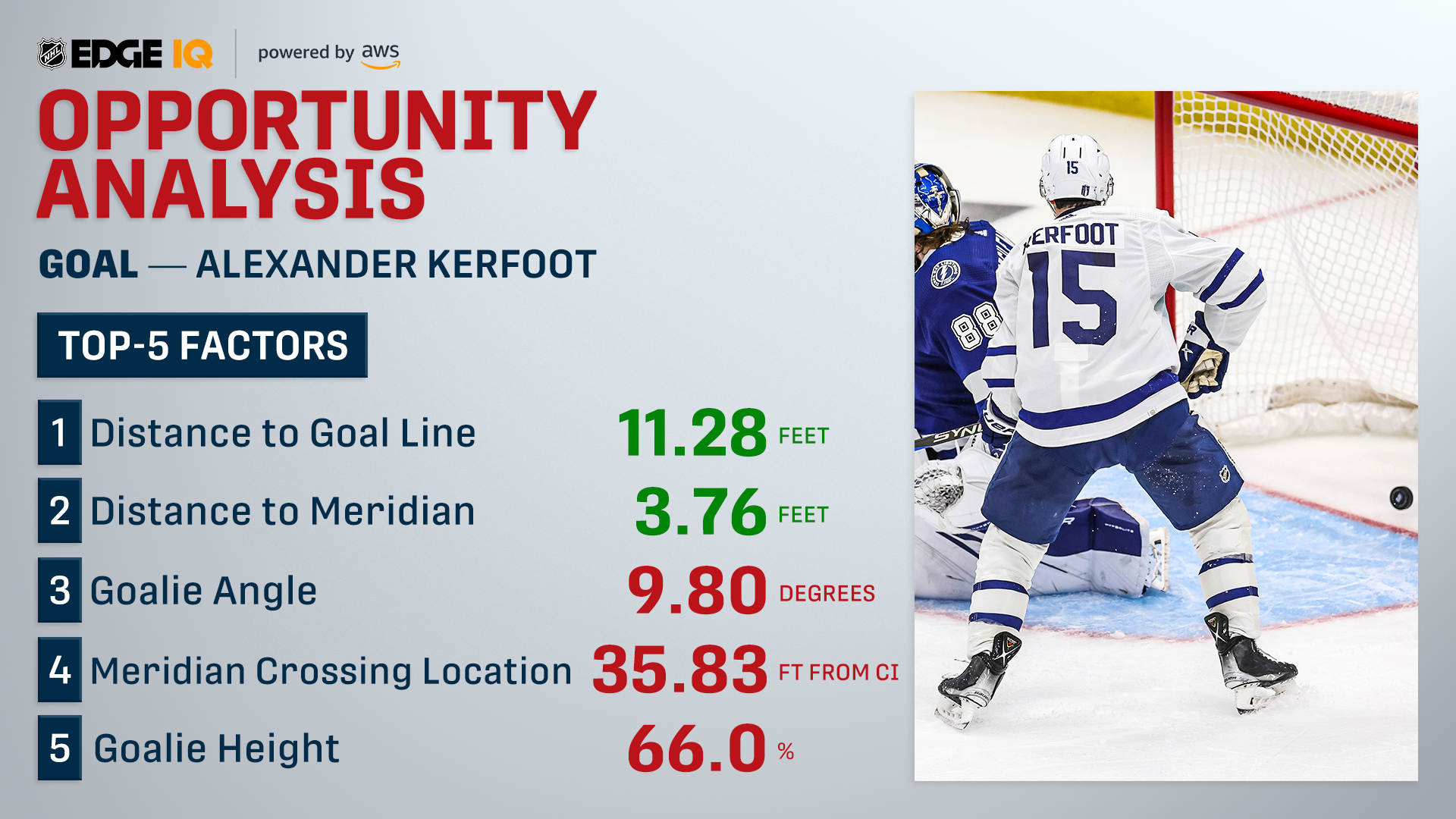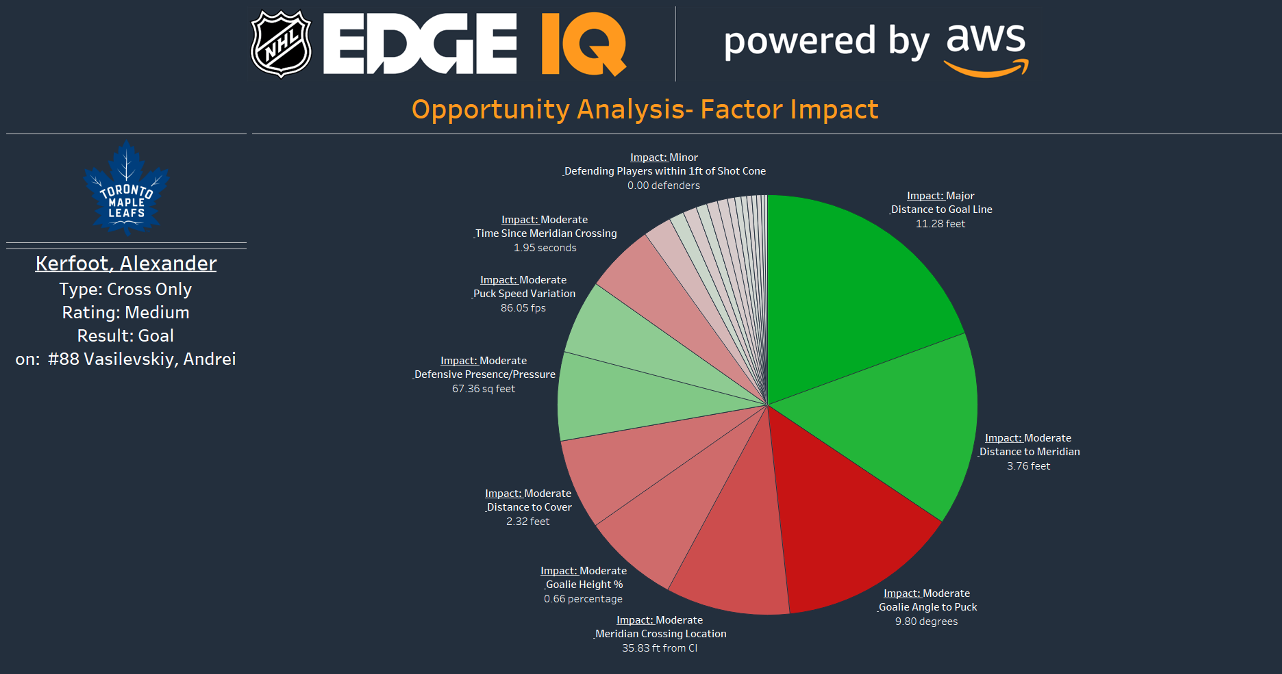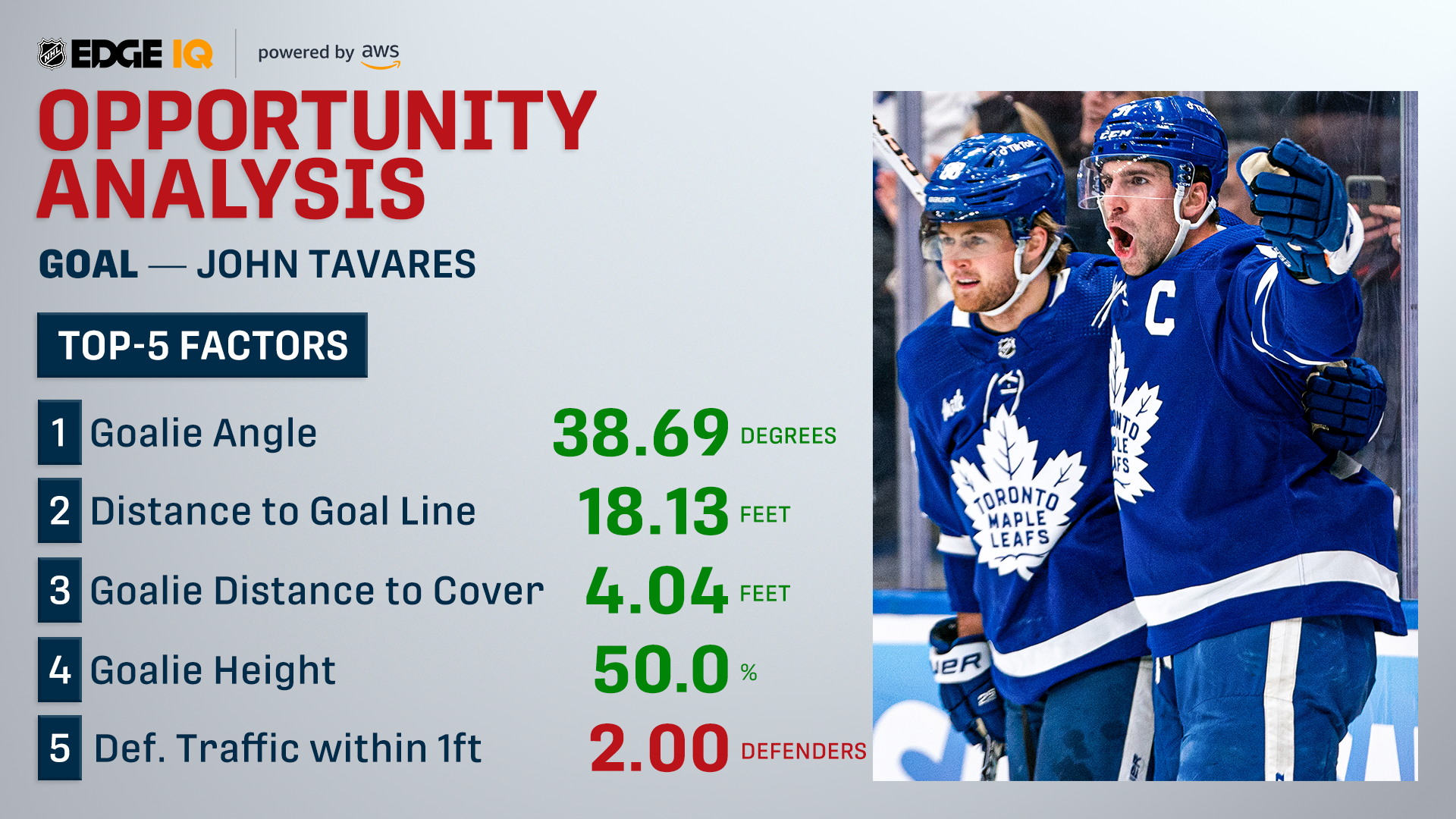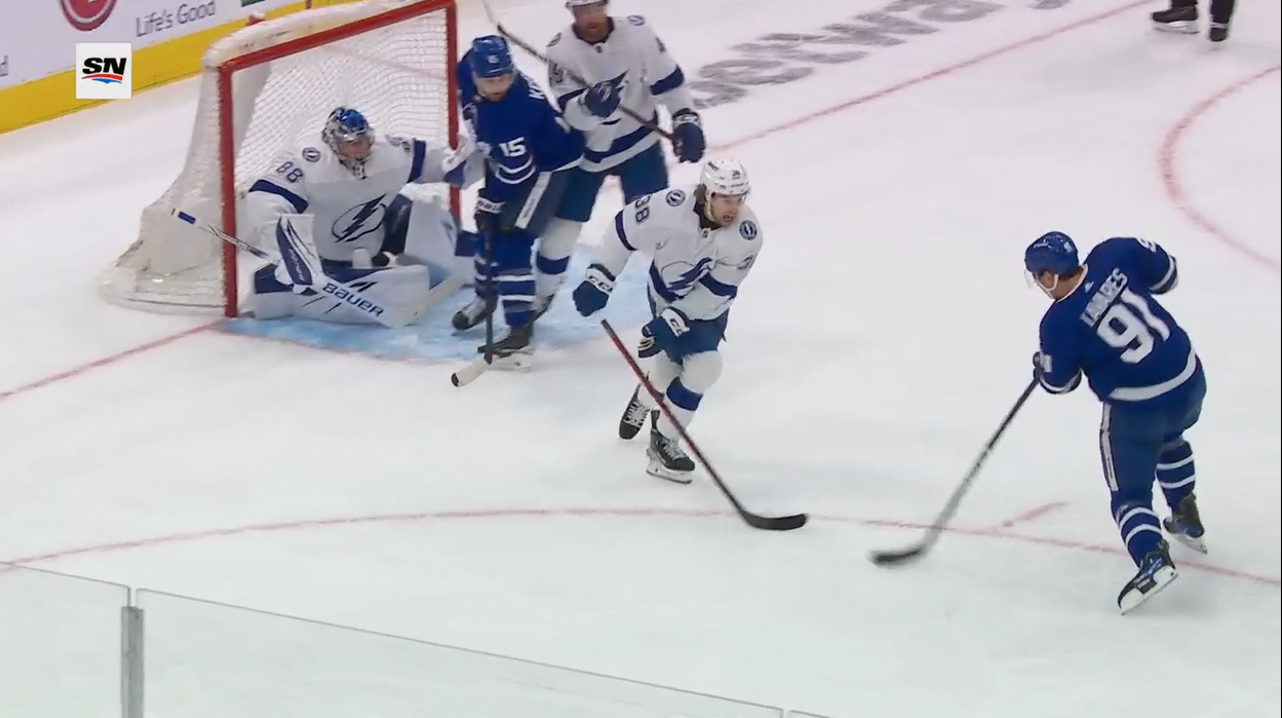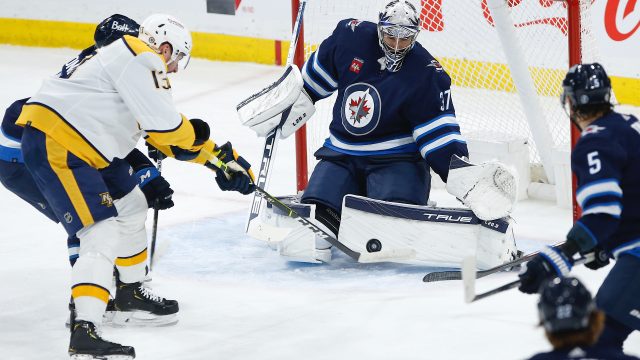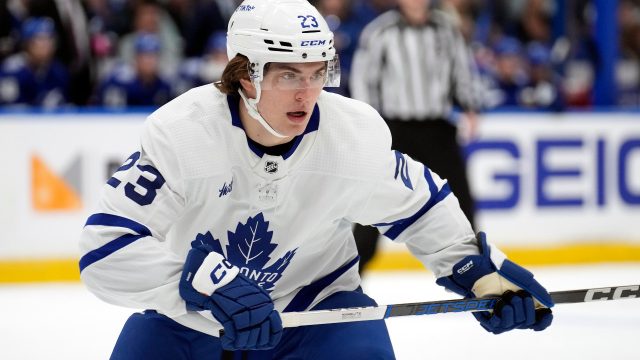
Of all the insights that can be pulled from NHL EDGE IQ player and puck tracking data (powered by AWS), I might be most interested in the stuff that involves puck movement and coverage. I’m fascinated by things like measuring the defensive pressure on a shot, which they do by measuring players in the “shot cone,” as explained here in my introductory piece on player/puck tracking (to better understand what’s about to follow, that article may be a good place to start).
More interesting than anything, though, are the insights to be gleaned about goaltending.
One area of the sport that’s historically been under-coached is the offensive side of the puck. On defence, coaches set up systems and have set positions and rotations they expect. It’s an overall intense strategy. On offence, it’s typically been a shrug along with “Well, an offensive player has to use their instincts and take what’s given, that’s up to them.”
What looking at all this data highlights to me is how much building an offence should be about finding a plan that focuses on the goalie, rather than just trying to create cracks in the defence. You can create Grade A chances, but when they’re on a square and set goalie the likelihood of scoring is still lower than a pretty mediocre shot taken when the goalie is under duress.
Through four games of the Toronto-Tampa Bay first round series, the universally accepted “best goalie of this generation” – Andrei Vasilevskiy – has looked remarkably human. Toronto has scored 19 goals on the big Russian keeper, which leads to an obvious question for us to dig into: what are the Leafs doing to neutralize The Great Vasy Advantage?
Your first thought may go to the Game 4 goal where Mitch Marner hits Auston Matthews with a lateral pass on a rush that leaves Vasilevskiy diving across the net to attempt a save. So have they moved the puck east-west well? Have they peppered him with a ton of shots?
The answers there are no, and no. That Matthews goal was an outlier, as lateral movement or workload haven’t at all been the issue.
The microchip in the puck, lined up with the chip in the back collar of Vasilevskiy’s jersey (as well as knowing the location of the posts) tells us that, in fact, Vasilevskiy has actually done a great job getting square to Leafs shots.
Opportunity Analysis data is unique in that it sorts the factors that had the biggest impact on the likelihood of a shot going in or not, both the positive and the negative. For example, if you had a 2-on-0 that saw a crisp lateral pass followed by a clean one-timer that was taken from around centre ice, there would be a lot of positive factors on that play of course, but the biggest negative factor would be distance from the goal line, and it would kill the “projected goal rate” of that play. In that made-up example, “distance to goal line” was one of the biggest factors.
On eight separate goals the Leafs have scored this series, Vasilevskiy’s angle to the puck has been one of the top-five impacts (out of 25) on an attempt in a negative way. As in, he’s been so square to the shot attempt that it lowers the projected goal rate significantly.
And yet, the pucks have found their way in.
From this sort of fascinating detail, we’re left to draw our own inferences about what’s going on. Watching the goals back – some of which we’ll do together in a minute here – is where we get our teaching point, and is a great example where data and video together can bring us somewhere helpful.
All season long the Leafs were a middle-of-the-pack team at creating screened shots and goals. Against Tampa Bay, where they’ve had trouble getting to the inside with the puck, they’ve been getting bodies to the inside, then firing the puck into the traffic, which is a good “next-best” option for an offence. Toronto has scored more screened goals and created more screened rebounds than any playoff team through four games each.
There’s another relevant detail here, too: part of that may be by necessity (Tampa is defensively sound), and part by strategy. Sportsnet’s broadcast on Monday night featured former Tampa Bay assistant coach (and current Detroit Red Wings head coach) Derek Lalonde, who shared a little nugget about the Bolts’ goaltender. He noted:
“One thing actually, we did a study back in the day, (Vasilevskiy) was one of the lower percentage goalies at finding pucks from the point, so we actually changed our entire D-zone…”
With that in mind, it’s very possible it wasn’t just Tampa’s D keeping the Leafs outside that’s inspired a few more shots from distance, but rather strategy.
There’s another element at play here, which I think is the real story. Since we’ve never known this Leafs team to be a “park in front for screens and tips”-style offence, their ability to do it so successfully this series turns your eyeballs to something else that was suspected would be a problem for Tampa Bay: defensive depth.
Auston Matthews’ first goal of the series in Game 3 comes after he parks in front of Darren Raddysh (moments after bodying the smaller D-man off the puck), wins offensive position, then redirects a shot that Vasilevskiy was square to.
The second biggest impact on that goal – a negative one that took away from the likelihood of the attempt going in – was how square Vasilevskiy was to the play. Yet it goes in anyway, because the opposing player is allowed to stand in front and tip the puck.
This is what Lightning coach Jon Cooper had to say about Vasilevskiy, both in his defence and as commentary on what the Leafs are doing successfully (via beat writer Chris Krenn):
“I look through this series, the Marner goal in Game 2, he for sure wants to have back. But then after that, realistically, what are we saying he’s done wrong other than make all the saves he’s supposed to? Look at last night. Who’s stopping the Acciari tip? Nobody’s stopping that. And who’s stopping the Matthews tip? Nobody’s stopping that.
[…] I think the onus is on the guys in front of him to try to be a little bit better. In the end, give Toronto credit for some of the plays they’re making. I think if you took all of Toronto’s games, like their last 10 games, I bet you they don’t have all those types of goals. It’s something that we’ve got to be better at and hopefully Toronto digresses a little bit in that department.“
It’s definitely not been a staple of the Leafs’ offence. Look at what he’s talking about here.
The Leafs lost Game 1, but the William Nylander power play goal became a blueprint for them. A shot from distance where the goalie is square to the puck, but can’t keep tabs on it through traffic:
As you can see, goalie angle is again a top-five negative impact on the goal. Vasilevskiy is where he’s supposed to be to start, but he just can’t manage finding the puck through the bodies.
“Goalie vision blocked” is a yes or no input, and in this case, yes there’s a player directly in Vasilevskiy’s line of sight to the puck. “Goalie height” is listed as a percentage of their full standing height, and generally speaking the lower goalies find themselves, the more trouble they’re in (it’s a little more complicated than that, but the sweet spot is north of 65 per cent. Anything below 60 per cent and they’re really starting to get in trouble). So those factors in green increased the odds of that shot going in, while Vasilevskiy being square to the puck lowered the attempt’s chances.
And to Cooper’s point, how about Noel Acciari’s tip in Game 4:
Vasilevskiy is once again dead square, until the puck changes direction in a significant way on the way to the net. That shows up in the player/puck tracking data again, with the goalie’s square angle to the puck taking away from the likelihood of the shot being a goal.
And on the Game 4 OT winner, the Lightning goaltender is once again on line with the shot. Power play or not, the theme of something coming between Vasilevskiy and the shots that come from distance has left him with a save percentage of .856, and with some metrics having him giving up five goals above what would be expected from league average goaltending.
But that’s hardly a fair expectation given the tips and screens.
On Kerfoot’s winner, the puck last crossed the middle a long way out from the net, Vasilevskiy is square and in the sweet spot of goaltending height.
For those who really want to dig in on this stuff, here’s a pie chart that shows how the varying factors played out on the Game 4 winner using NHL/AWS data, starting with the biggest ones and working around like a clock to the smaller impacts on the play. The tipped puck and the player standing alone in front show up in “defensive pressure” (there’s none here on Kerfoot at all), and “puck speed variation,” which shows the tip.
The above examples are just a few of the many where Vasilevskiy has managed to stay in the direct path of the puck at the time of release. Sometimes the traffic has been so heavy that his angle shows up in the data as being “bad” simply because he has to look around it, which leaves a chunk of the net open. On this Tavares goal, we see Vasilevskiy’s angle is a major factor on the projected goal rate, this time in a way that increases the likelihood of the shot becoming a goal. In fact, he’s way off-line.
The same problem of chaos and traffic in front of him this time pushes Vasilevskiy’s angle way off. Tavares is shooting this to the right of Brandon Hagel’s legs, while Vasilevskiy is looking around the pile from the other side:
So all the above leads me to wonder — and I’m sure Jon Cooper does as well: Would Erik Cernak have done a better job clearing Matthews out on that first tip goal? Would Ryan McDonagh have done a better job fronting the Nylander shot? Would Jan Rutta have been quicker to get Alex Kerfoot’s stick off the puck on the PK in overtime?
Is this the place where Tampa’s softened D-core is showing up, and are they able to right the ship by boxing out better?
It’s not like having a downgraded group of defenders is allowing the Leafs a free pass to blow by guys wide and score off the rush. Tampa Bay’s total team defence is too good. But it’s shown up so clearly at the net front that now the goalie is getting the blame, despite his coach’s protestations.
Vasilevskiy hasn’t been perfect and I’m sure he’d tell you the same thing. But the Leafs have made his life hard by getting to the front of the net, shooting from distance, and making it all but irrelevant how square to the puck Vasilevskiy’s been able to get at the time of release.


